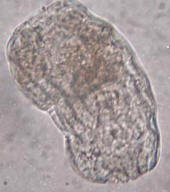|
|
|
Call
Today
951-303-3471
9-5 Pacific |
|
|
|
|
|
|
|
|
|
|
 
Cysts.... Real
Pests in Our Drinking Water
Cryptosporidium, Giardia Lambia
("Beaver Fever")
This
organic sporozoan, first described in 1907, wasn't
recognized as a cause of human illness until 1976.
It is a protozoan parasite that can infect a variety
of animals. In the environment, Cryptosporidium
exists as a resilient, infectious, round oocyst
about four to six microns in diameter. The cyst is a
"suitcase" for the infectious material inside.
Cryptosporidium is widespread in the
environment. Oocysts (cysts) have been found in
rivers, streams, lakes, reservoirs, sewage, and
treated surface water. Once introduced to water, the
oocyst can survive for weeks, even at low
temperatures. The organism has been found in humans,
cattle, sheep, swine, goats, cats, and dogs as well
as deer, raccoons, foxes, coyotes, beavers,
muskrats, rabbits, and squirrels. Oocysts infecting
certain species can infect another (referred to as
cross-transmission). For example, organisms from
domestic animals (cattle, dogs, eats, etc.) are able
to infect humans, Conversely, organisms from humans
can infect animals. Consequently, animals which
typically reside in or around watersheds may serve
as hosts to the cysts and continuous sources of
infection. This is where the nick name "Beaver
Fever" was born. Beavers carry the organisms and
through their feces spread it throughout surface
water supplies without becoming ill themselves.
Moreover, infection can occur not only from drinking
contaminated water, but also from eating
contaminated food and from exposure to fecally
contaminated environmental surfaces.
When ingested, the Oocysts pass
through the stomach into the small intestine. There
the Oocysts split open, releasing sporozoites which
invade the cells lining the gastrointestinal tract.
Infected cells lining the intestine appear normal,
but their ability to absorb water and nutrients is
severely impaired. The water and food ingested
simply passes through the digestive system.
Additional Oocysts are formed in the intestine and
either split open to release additional sporozoites
to continue the infection or are excreted in the
feces.
The Cryptosporidium infection causes
an illness called cryptosporidiosis. After the
Oocysts are ingested, the incubation period
typically varies from 2 to 12 days with an average
of seven days. Disease symptoms include diarrhea,
abdominal cramps, nausea, occasional vomiting and
low-grade fever.
The number of Oocysts that must be
ingested to cause infection in humans is not
conclusively known. Studies indicate that as few as
10, and perhaps as many as 500 Oocysts are required
to initiate infections in mammals. The infectious
dose for humans is thought to be fewer than ten.
Cryptosporidiosis typically lasts 10
to 14 days. However, it may linger off and on for up
to 30 days and infrequently can persist for extended
periods. Children may be the most susceptible,
particularly six-year- olds and under. A rapid cure
for Cryptosporidiosis has not been found. Recovery
depends on the patient's overall health and immune
system. The disease can be fatal for those who are
already in a fragile state such as someone with AIDS
or any other weakness to their immune system.
There are two varieties of the
oocyst: (1) a sphere of about 4.5 micron in diameter
and (2) an ellipse of about 7 x 5 microns. The thick
walls of the Oocysts make it difficult, almost
impractical, to kill with the UV systems in most
domestic water treatment systems. Also, the cyst is
much more difficult to kill using
chlorine than
normal coliform bacteria found in water supplies.
Since filter elements are
manufactured so that they remove pathogenic bacteria
down to one micron in size; they are 100% effective
in the removal of Cryptosporidium.
Cryptosporidium Fact Sheet
What is
Cryptosporidium?
Cryptosporidium is a
one-celled parasite that can cause a
gastrointestinal illness called cryptosporidosis.
Where does it
come from?
Cryptosporidium occurs in the feces of infected
animals or humans. It is environmentally resistant
and may survive outside the body for long periods of
time. To become infected, a person must consume
contaminated food or water.
What are the
symptoms of cryptosporidosis?
Diarrhea, abdominal cramps, headaches, nausea,
vomiting, and a low-grade fever.
These symptoms can last for weeks and may lead to
weight loss and dehydration.
Symptoms are more severe for people with weakened
immune systems and can lead to death.
Who are people
with weakened immune systems?
Those on chemotherapy, organ or bone marrow
recipients, persons with HIV or AIDS, malnourished
children, the very young and the very old.
When do symptoms
appear?
From
2 to 12 days after ingestion. The average is seven
days.
How is it spread?
A
person can be infected by consuming contaminated
water or food. Direct or hand-to-mouth transfer of
the bacteria from feces or contaminated surfaces can
also cause infection.
What is the
treatment for cryptosporidosis?
If
you think you have cryptosporidosis, see a health
care provider, especially if you have a weakened
immune system. There is no cure for the disease.
However, the symptoms may be treated with
antidiarrheal drugs.
Who is at risk?
Anyone who consumes contaminated food or water,
child care workers, young children who attend child
care centers, persons exposed to human feces by
sexual contact, and caregivers who might come in
contact with feces while caring for a person
infected with cryptosporidosis. Children are
especially susceptible because they put so many
things into their mouths.
How common is
cryptosporidosis in Washington?
Cryptosporidosis is not a reportable illness in
Washington. Originally considered a parasite of
animals, reptiles and birds, it first was detected
as a source of illness for humans in 1976. Health
officials now believe Cryptosporidium has
been causing human illnesses for a long time, but it
was overlooked due to difficulties in testing and
diagnosis.
How can I ensure
my water is safe to drink?
Pay
attention to health advisories and boil water
notices. To ensure your drinking water is safe
during boil water notices, always boil, filter, or
use bottled water:
What else can I
do to avoid cryptosporidosis?
The
single, most effective way to avoid illness is to
wash your hands often with soap and water. During
boil water advisories, use water that has been
boiled and cooled, filtered, or safely bottled for
washing dishes, fruits, and vegetables.
-
Always wash your hands before handling
food and dishes and after using the toilet,
gardening, changing diapers, or handling
pets.
-
Wash fruits and vegetables with safe
water, especially if you plan to eat them
raw. You can also peel fruit that you will
not cook.
-
Never cook for other people if you have
diarrhea.
-
Avoid unpastuerized milk and dairy
products. Cooking kills Cryptosporidium
and other germs.
-
Don't swallow any water from lakes,
rivers, pools, or jacuzzis. Water swallowed
accidentally while swimming may contain the
organism.
-
Take care when traveling in developing
countries. Foods and drinks, in particular
raw fruits and vegetables, tap water or ice
made from tap water, unpasteurized milk or
dairy products, and items from street
vendors may be contaminated with Cryptosporidium. Talk to your health
care provider about other precautions you
may want to take when traveling abroad.
Are these
recommendations sufficient for people with weak
immune systems?
For
most people, yes. However, persons with AIDS should
use disposable gloves or have someone else who is
not HIV positive change the cartridges on their
water filter. The same precautions should be taken
with cat litter boxes.
Where can I get
more information?
For
more information, call Communicable Disease
Epidemiology (360) 361-2914.

 |
| |
|
 |
Removes
the BROADEST RANGE of
Toxins! |
 |
NO filter
media changes or repacking!
|
 |
Lasts up to
15
YEARS or longer! |
 |
Patented System |
The
Wholly Water Purification System Includes the Following:
- 6-Bed, 5 STAGE
Patented Water Filter
-
Dedicated Long-reach Faucet
- Pressure
Regulator - 3/8 inch
- Sonic Flood Alarm
- Easy
Instructions
-
2 year warranty
-
Can split to feed Icemaker/Frig water
dispenser
Chlorine - ALL Heavy Metals
- PCB's -
Organic & Inorganic - VOC's
Radionuclides - Bacteria -
Cysts - MTBE -
Pharmaceuticals
Better than bottled water. Better than R/O. Better than any other filter!
 |
|
|
|
Featured Products |
|
 The
Wholly Water Filter Does it ALL! SIX recognized forms of
filtration wrapped into ONE filter! Removes ALL
types of toxins, including VOC's, Organic and Inorganic poisons,
including Fluoride, Arsenic, Mercury, Lead, Drugs, Parasites and
Cysts, and more! No other SINGLE filter does all this. The
Wholly Water Filter Does it ALL! SIX recognized forms of
filtration wrapped into ONE filter! Removes ALL
types of toxins, including VOC's, Organic and Inorganic poisons,
including Fluoride, Arsenic, Mercury, Lead, Drugs, Parasites and
Cysts, and more! No other SINGLE filter does all this.

 The
Vitalizer Plus will rejuvenate you! Super cellular
hydration, increased cellular oxygenation, high alkaline pH, and
more. The
Vitalizer Plus will rejuvenate you! Super cellular
hydration, increased cellular oxygenation, high alkaline pH, and
more.

 Kangen
Water - The Most Powerful Water in Existence! Highly
alkaline, ionized, anti-oxidant rich, microclustered, powerful
living water! Flushes Toxins and Neutralizes Acid throughout
your ENTIRE body. Kangen
Water - The Most Powerful Water in Existence! Highly
alkaline, ionized, anti-oxidant rich, microclustered, powerful
living water! Flushes Toxins and Neutralizes Acid throughout
your ENTIRE body.

 P250
Ozone Generator. An ozone level of just 0.04ppm
in just 4 minutes has been shown to kill 99.9992% of all
pathogenic germs in water while destroying 99.9992% of all
pollutants in the water simultaneously! P250
Ozone Generator. An ozone level of just 0.04ppm
in just 4 minutes has been shown to kill 99.9992% of all
pathogenic germs in water while destroying 99.9992% of all
pollutants in the water simultaneously!
 |
|
Did You Know? |
|
Each year 1.2 trillion gallons of untreated sewage, storm
water, and industrial waste are dumped into US water.
- "How Infastructure Makes Water
Work for Us." In Urban Green: Architecture for the
Future. |
|
Approximately 40% of the lakes in America are too polluted
for fishing, aquatic life, or swimming. -
"Nonpoint Source Pollution: The Nation's
Largest Water Quality Problem." Environmental Protection
Agency. Accessed February 18, 2014 |
|
14 billion pounds of garbage are dumped into the ocean every
year. "Marine Debris."
- California Coastal Commission. 2014 |
|
According to Environment
America, 226 million lbs. of toxic chemicals were
dumped into 1,400 waterways of the United States in 2010
alone.
|
| |
|
|
|
|
|
Call Today
951-303-3471 9-5
Pacific (12-8 Eastern)
|
|
Statements
about water pollution, Waterboy water filters, Kangen water machines, Wholly
Water filter, The Vitalizer Plus, the P250 Ozone generator, etc. have
not been reviewed by the FDA.
|
|